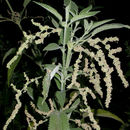en
names in breadcrumbs


Stinging Nettle
Urtica dioica or stinging nettle is a broadleaf angiosperm and of the Urticaceae family. This perennial typically grows to between 1-3m tall with dark green leaves in an opposite pattern that are oval to heart shaped and saw toothed and are sparsely covered with stinging (and nonstinging) hairs (Schellman and Shrestha 2008). The flowers are green to white in color, with drooping clusters of four petals per flower, and occur in the leaf axils as well as at the stem tips. The fruit of the stinging nettle are small, flattened, lenticular achenes (Pojar and MacKinnon 2004).
The native range of Urtica dioica spans Europe, Asia, northern Africa, northern Mexico, and, in Canada and the US, every province and state except Alabama, the District of Columbia, Georgia, North Carolina, Virginia, in all of which it has been introduced, and Hawaii, where it is absent (CABI 2016), and it is typically found in meadows, thickets, and open forests as part of the understory of riparian ecosystems (Pojar and MacKinnon 2004). Stinging nettle thrives in temperate climates, particularly in wet soil that is rich in nitrogen.It prefers full sunlight and is often able to survive in areas where few species can. Generally, stinging nettle does well near rivers or lakes, but it can also be successful in environments subjected to human degradation, or on farm lands because of the rich nitrogen levels in the soils (Carey 1995). Since it grows in abundance in many locations, stinging nettle can be considered a common weed. And although it is native across a wide global range, it is often perceived as invasive due to its irritating and rather prolonged sting (CABI 2016). Stinging nettle germinates in the spring and continues to grow until late fall and individuals and colonies can also continue to regrow for many years due to their rhizome system. Rhizome pieces or parts of stems have the ability to grow into mature plants if proper conditions prevail (Schellman and Shrestha 2008).
Stinging nettle is a food source for many butterflies and aphids and the plentiful seeds provide nourishment for birds as well. Historically, the plant was cultivated for food and other industries in European countries such as Scotland, Denmark and Norway for food and other industries. Young stinging nettle can also be cooked and eaten, since cooking the leaves destroys the sting (Kew 2016; Pojar and MacKinnon, 2004). Stinging nettle has also been used in fabric dye and the tough fibers of the stems have been used for textiles (Schellman and Shrestha 2008).
Stinging nettle is infamous for its painful sting that is caused by toxins from the hairs on the stems and leaves, which apparently evolved in order to keep animals from eating the nutritious plant. These stinging hairs are needle like tubes that can pierce the skin and inject histamine and acetylcholine, which causes burning and itching that can last up to 12 hours. Nettle stings have also been found to have an anti-inflammatory property and can be used for medicinal purposes, and preparations derived from the root are used in treating benign prostate hyperplasia (Kew 2016).
This site is dedicated exclusively to providing extensive information on Urtica dioica, the common stinging nettle, a plant that could well be named, "Nature's Multivitamin" given its concentration of vitamins and minerals,
Traditional healing uses from around the world are explored along with the latest scientific research on this medicinal plant. Find recipes and more as you discover the virtues of this common plant with uncommon powers. There is also a store selling Vermont organic stinging nettle tea and other local Vermont products with nettles.